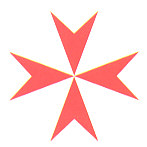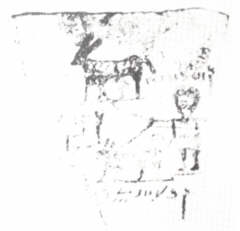
Documents
-
Name
-
FCI Breed Standard
-
Amendments
-
Egypt-Malta
-
Study on Genome
-
Judging
-
Lure Coursing
-
Breeding
-
Rural Culture
Egypt - Malta and vice versa?
In
an article in one of the local newspapers*), a renowned researcher, Dr.
Louis Vella LL.D., wrote an article which left me quite amazed. I read the
article over and over to confirm that what I was reading was if fact true
and not a fragment of my imagination.
Dr.
Vella says that while doing some research at the National Library in
Valletta, he came across a work by Margaret Murry, an English Egyptologist,
entitled "Corpus of the Bronze Age Pottery of Malta", published
in 1934. This publication contained a particular plate namely an Ostrakon,
depicting a man holding two dogs (see illustration), described as a
"Roman Ostrakon showing a Maltese Dog".

The Roman ostrakon
This
is what the author comments on the illustration in question: "An
ostrakon in the library of Strasbourg University is published in the
'Zeitschrift für ägyptische Sprache', XLIX, pl. VI,4. It shows a rude
drawing of a man holding two dogs, with a descriptive inscription in
demotic against each figure. At the side of the upper dog are the words
‘wa simos’ meaning 'a snub-nosed'; below the lower dog is written
‘wa mlithin’ meaning 'a Maltese' and in front of the man is his
description 'a man who holds them'".
The
Ostrakon was found in Egypt, and according to Dr. Vella, the style of the
script indicates the beginning of the Roman Period in that country. Dr.
Vella continues to say that it is particularly interesting to obtain so
intimate a piece of information about Malta, since this is proof that the
small island, even at that early time, was known for a special breed of
dogs.
In
the past decades, much importance has been given to the supposed Egyptian
origin of the Kelb tal-Fenek. After the breed has been given the name
"Pharaoh Hound" by the British Kennel Club, many foreign
breeders have tried to justify this decision by inventing fancyfull
stories about the glorious past of the breed in Egypt. Everything is
erronously based of the similaritiy between the modern Kelb tal-Fenek and
the ancient Egyptian "Tesem" hound and the jackal-headed deity
Anubis.
However,
none of this stories is based on scientifically proven facts, but rather
on wishful thinking and on the desire of people to interpret things in the
very own way they want to see them.
Now,
there is another theory which concludes that, at least in a certain period
of its history, ancient Egypt has received a hound of Mediterranean type
from Malta, which showed some similarity to our modern Kelb tal-Fenek.
Starting from Dr. Vella's article, now we could argue that the Ostrakon,
found in Egypt and with ancient Egyptian demotic script, proves that even
in those early days our beloved Kelb tal-Fenek was considered in Egypt
itself as of "Maltese Origin".
I
am aware that many "Pharaoh Hound" fanciers abroad will now
argue against this conclusion by pointing out that this new theory is just
based on an optical similarity between the modern Kelb tal-Fenek and the
dog depicted on the ostrakon, that there is no proof for a genetic link
between the modern hounds and the dog on the ostrakon, and so on.
I
confess they are right. It is an interesting theory, but it is not yet
proven by scientific research, but only based on some superficial
similarities - just the same as the popular thesis of the Kelb tal-Fenek's
origin in ancient Egypt!
Now
that we agree on this point, we should remember that the word "cynology"
means "The science of the dog". Each canine organisation, which
considers itself as a "cynological" body (just as the FCI, the
British and the American Kennel Club do) should strictly stick to facts,
and it should not been carried away by the fascination of wishful thinking
nor by the personal interests of certain people.
Certain
foreign fanciers of the Kelb tal-Fenek have long called this dog "Pharaoh
Hound". This is because of the marked resemblance of the breed to the
depictions on the ancient Egyptian tombs. This gave the breed an air of
mystic and so intrigued many people to purchase a puppy for prestigeous
reasons. However, true lovers should realise that the name "Pharaoh
Hound" neither corresponds with the true origin of this breed, nor is
it based on any scientifically founded facts about the breed's
history.
We
all know in which country our beloved breed was exclusively found until
foreign fanciers became interested in it, we do also know for which
purpose it is still used in this country, and we do also know the name
which is used for this breed in the country of origin since a very long
time: Therefore, every serious canine organisation and any true lover of
the breed should not call it in any other way other than by its true name
"Kelb tal-Fenek" - the Maltese Rabbit Hound.
Peter
Gatt/Jan Scotland
*) 'Malta: ancestral home of the Ancient Egyptians'. The Sunday Times of Malta, March 26th, 2000, page 50ff